|
|
I think that’s the mantra when they teach people to dance some type of classic dance…quick, quick, slow. Might be the two-step. Or not. 😉
Anyway, this is post is about things that move quickly and things that move slowly.
Last post I promised photos of the 4 scarves I’d woven at the end of June. First up is a scarf in which I successfully used ladder ribbon as a supplemental warp.
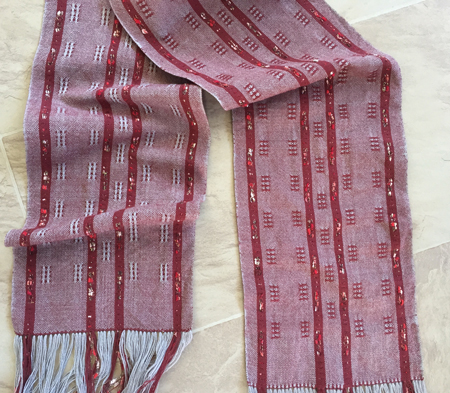
I’d tried using ladder ribbon before and hated it. I’d also tried some supplemental warps before, not successfully. I had to try again, with both, after a recent Guild meeting when a fellow weaver showed some yardage she’d made. I asked lots of questions, and she told me the draft was in a Handwoven magazine (November/December 2000).
I got my hands on this issue, copied the appropriate pages, and then made a bunch of changes to the draft. I only warped my loom for 1 scarf, since I wasn’t at all sure I’d like it. I used 10/2 cotton, sett at 24 EPI. Winding, beaming, and weaving all went rather quickly.
I’m not overly fond of the colors, but will use a similar draft in the future, both with more of the ladder ribbon and some other ribbons I have.
Then I warped my loom with my last batch of handpainted yarn, this one being the blue-green tencel. I threaded the loom for Tara Oftenorth’s snakeskin variant, and wove the first scarf with a medium blue weft. I love it.
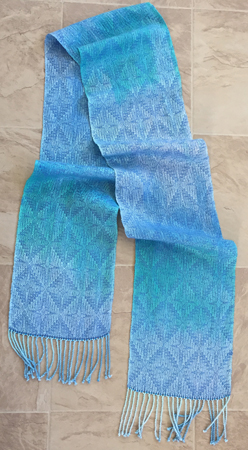
Just because I could, I added some sweet little beads to the fringe.
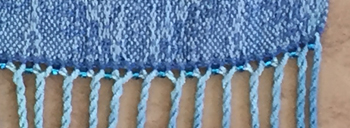
Next up I used an odd, bright green rayon weft I’ve had forever. This yarn is definitely not my favorite color, which is why I’ve had it forever. But it worked perfectly with this warp.
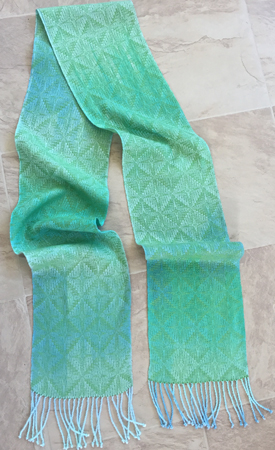
I had enough warp left for a short cowl. After auditioning several different colors of weft, I returned to the odd green since it worked so well. I modified the treadling to be a simple zigzag pattern.
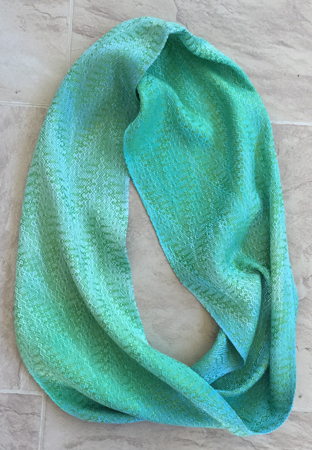
After picking and making some more cherry stuff, I went back to the loom. I decided to use just one motif at a time for my transparency, not drafting out a cartoon for its entire length. This will both save time and hopefully make the actual weaving a bit less cumbersome. It’ll also be a bit less planned, and hopefully that will work well.
My sister was interested in how I wove the transparency. When I explained it to her, and that I needed several ‘bundles’ of yarn of each color, she was a bit amazed. I thought I’d take a photo of weaving in process so everyone could see it in all its messy glory. S.L.O.W.
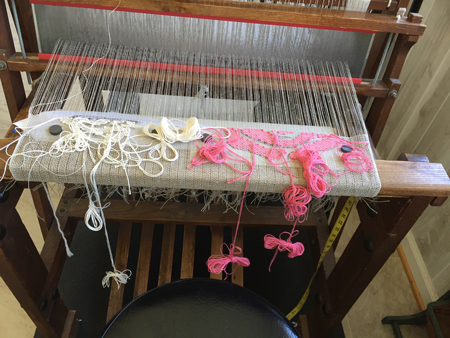
Since there are lots of ends to weave in, I decided that given my temperament I was better off to do that for each rose as I finished it, not waiting till it was all off the loom and I’d have about a gazillion ends staring at me. Again, S.L.O.W.
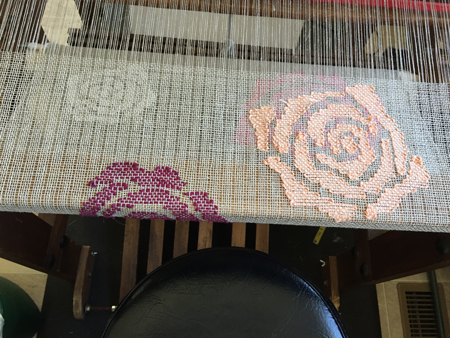
You’re seeing the wrong side of the weaving there. That’s the side I work from. So here’s an in-process snap of the right side.
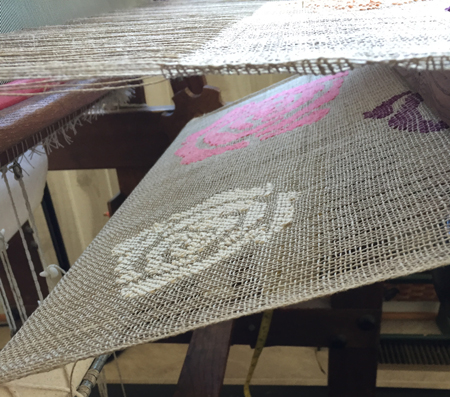
Completely unrelated to weaving, on my walk the other morning I came across these infested leaves on the sidewalk. I have no idea what kind of creature was living in these ‘bumps’ nor was I going to bring one home and watch it. So your input on the nature of this phenomenon will be appreciated.
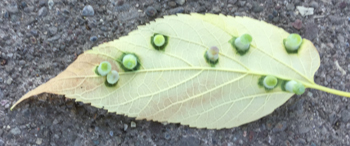
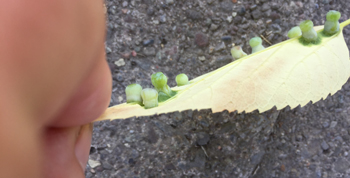
Gotta get back to work. I still have to warp my rigid heddle loom for demos this weekend. I’m planning to use a variegated thick-ish sock yarn. Hope it works well. I’ll wind a tiny sample on my little jig for a test of sorts.
I do have 4 more scarves woven, but haven’t taken their pix to show you. Soon. Be patient.
Meanwhile, here’s what else I’ve been up to since last post…
Spending time with my family. Helping mom out with school done, I’ve taught the 6-almost-7-year-old to make gods eyes. We also started making a potholder, but he wasn’t into it. It’s still on the potholder loom but I doubt he’ll ever finish it. Next day, when it was raining, I took him to see a movie – Incredibles 2 – and to lunch.
There’s also been just hanging out and general family fun. With yesterday as my son’s birthday, there was a delicious dinner. I was responsible for dessert and since he wanted something cold, I browsed a few recipes and made this frozen chocolate dessert. I’m not recommending it. I bought high quality Green & Black Chocolate, 1 milk and 2 dark varieties since both my kids prefer dark chocolate. The dark was too…bitter? hard? Just too much. We all liked the milk section best. I put crushed ginger snaps between the layers, thinking it would add to the taste, but it mostly made things fall apart. That being said, I’m sure we should have let it sit at room temperature for a bit before cutting and eating it. Oh well.
I’ve also spent days doing this.
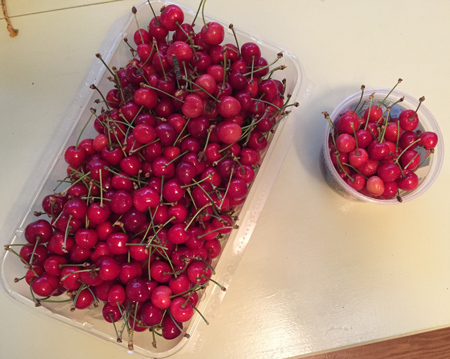 I saw a cherry tree laden with fruit on my early morning walk. I went back at a reasonable hour and knocked on the door. Was the homeowner going to use all the fruit? “Nope, help yourself,” he graciously replied. Although I didn’t weigh it, I’m guessing this was roughly 12 pounds of sweet cherries. Interestingly, these cherries didn’t have anywhere near as much flavor as those I buy in the store. I saw a cherry tree laden with fruit on my early morning walk. I went back at a reasonable hour and knocked on the door. Was the homeowner going to use all the fruit? “Nope, help yourself,” he graciously replied. Although I didn’t weigh it, I’m guessing this was roughly 12 pounds of sweet cherries. Interestingly, these cherries didn’t have anywhere near as much flavor as those I buy in the store.
I made a batch of mini pies, which didn’t look anywhere near as pretty as these, although they tasted fine. I brought one back to the nice man with the tree.
Then I made a batch of no-pectin jam. I used cherries, cranberries, and a whole lime, including the peel, chopped fine. It jelled well, but there are too many cranberries and too much lime, so the taste isn’t what I was aiming for at all. Too tart and bitter, despite lots of sugar.
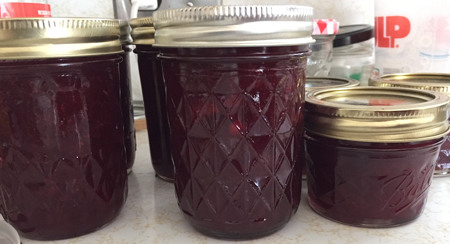
A few days later on a different route for my walk I noticed another heavily laden cherry tree, these cherries tart and much more flavorful. Again, later in the day I drove back and asked if I could pick some. “All you want,” was the response.
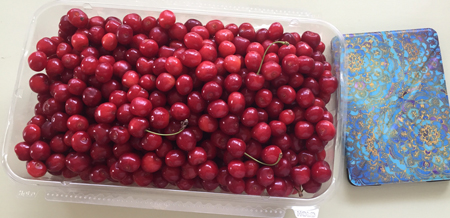
So I picked more cherries. This time I weighed them, and it was over 10 pounds, with my container not as full. (The kindle is there for relative size of my picking container.) I made another batch of no-pectin jam, this time with cherries and apples. Hmmm. It turned into a lovely cherry-apple sauce/spread, but certainly not jam.
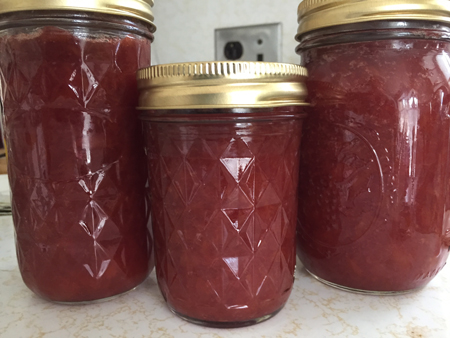 I also made some cherry topping to go on the frozen chocolate dessert. THAT was good! I also made some cherry topping to go on the frozen chocolate dessert. THAT was good!
I brought a pint of the cherry-apple sauce/spread back to the homeowner, who suggested I was welcome to bring a ladder to get more cherries if I wanted. I wasn’t quite into that, but did pick another batch of cherries, this time around 6 pounds. I made a delicious batch of regular old cherry jam with SureJell. Of course it set great and tastes lovely, if very sweet. I need to get some low-sugar pectin.
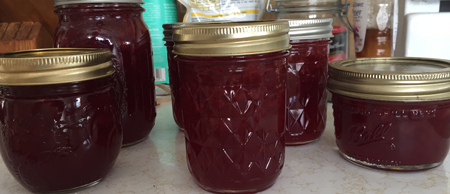
I also made it a point to warp up my little counterbalance loom with a 16/2 linen warp for a transparency, which I’ve been wanting to make since I took a class well over a year ago. Honestly, preparing the cartoon was a very time consuming process. Or so I thought. Until I started weaving the sample. THAT is SLOW weaving! It has lots of colors and yarns since I wanted to try out various weights and textures before I set about doing the ‘real’ piece. Here’s what it looked like just the loom. I’ve woven in all the ends here, but it’s before any wet finishing. My inlay yarns include 1, 2, and 3 strands of 8/2 cotton; 1 strand of 8/4 cotton; 1 strand of 8/4 cotton along with 1 and 2 strands of 8/2 cotton; single strands of cotton chenille in various weights; 1 strand of rayon boucle; 1 strand of cotton flannel, and tapestry wool.
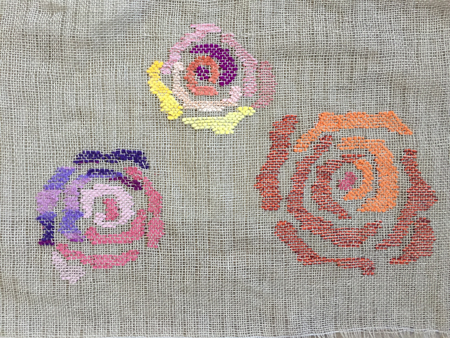
It’s okay, but I don’t like the ‘stripes’ you can see in the warp. I have a 12-dent reed and needed to set the threads at 10 ends per inch. I was anxious to see if that would even itself out in the washing and pressing process, so did that ASAP.
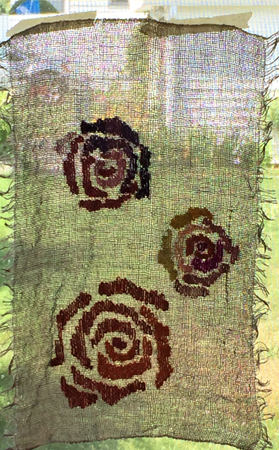
Here’s the piece stuck on my bedroom window with masking tape – classy, huh? It hasn’t been pressed yet, but you can get a better idea of the finished impact. I’m happy to know that the background linen threads all moved to create an even web.
Now I know that I have to modify my cartoon. First of all, I made it on the back of some old wallpaper I’ve used for warp packing. Only to learn via the sample that it is really too thick for this purpose. Second I learned that I prefer the look of the ‘crisper’ yarns; 1 strand of 8/2 cotton is too thin, 3 a bit too thick, 2 is Goldilocks just right for me. The wool may work fine, too, except that I only used it in my smallest rose, which makes it hard to determine how it would be in the larger rose. The chenille and flannel don’t suit my purpose. Finally, I learned that my smaller roses (the one that’s yellow and purple in the image) are too small to be worked well. Really only the biggest one looks good. Sigh. So I’m going to sit on this for a bit and think about how I want to proceed.
Oh, yeah. And I learned that the long, loom-woven, rayon chenille piece I wove for that Crafting Democracy exhibit was accepted. Yay! But now I have some work to do…more and better photos, and some more writing, by early August. No rest for the weary.
I’ve gotten six silk scarves woven and finished so far for June. I still intend to warp my loom with that lovely blue-green tencel I hand painted, and believe I can get it woven off pretty easily before the end of the month.
First I put on a warp of plain blue silk, threading the loom in a huck lace pattern I’ve used before. I used a slightly lighter shade of blue silk for the weft, and wove away.
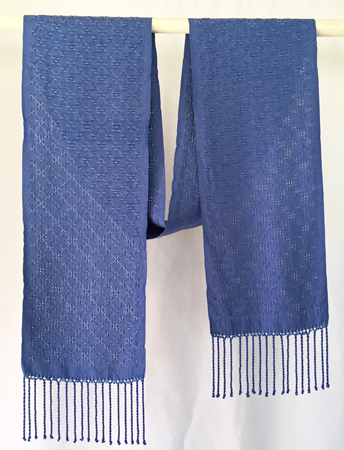
After it came off the loom I decided that this was the scarf to add beads to in the fringe, and luckily found some that were perfect for it in my stash.
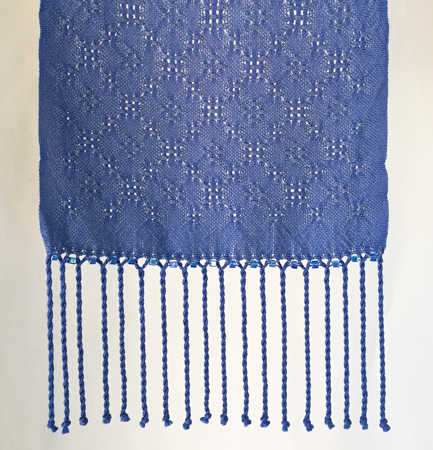
After this all blue scarf I decided to try and achieve some iridescence by using a red weft. I decided on a burgundy cashmere-silk blend, one that is so fine I had to use 2 strands together to approximately equal the weight of the 30/2 silk warp. It isn’t personally my favorite piece, but I hope it will call to someone else.
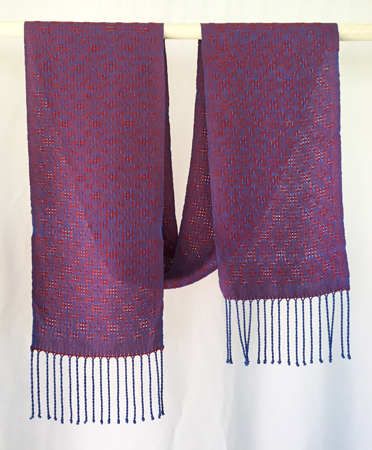
In this closeup you can see the lace design, and how light and airy it is, better than in the all-blue version. You can also see a bit of not-so-nice selvedge.

I obviously did something wrong in my calculations, because I thought I could get a short cowl out of this warp, too, but nope. I was at the end. So be it.
So then I put on that hand painted silk warp, the one that turned out very differently than expected.
As an aside, I asked my dye teacher about the difference in colors between the tencel and the silk, and she concurred, the two fibers dye very differently. It’s the difference between a plant fiber (tencel) and a protein fiber (silk). Still, when I showed her the photos of the two, she was shocked at just how dramatically different they were. She told me that cotton will turn out similar to tencel, as they are both cellulose based, but not the same. So, from here on, whenever I paint any fibers, I’ll make little butterflies of yarn of the other two fibers and paint them, too, to see the results. At least I’ll try to remember to do so. 😉
I decided to thread the loom with a huck lace draft that I spent HOURS working out a few months ago. I may have blogged about it; I can’t remember. Anyway, I had a few threading errors, which isn’t overly common for me, and had to tie some replacement heddles to fix them. I dislike tying those heddles and am far from quick at it, but it beats doing a ton of unthreading to correct errors in the middle of a piece, even when we’re only looking at about 240 threads.
I tried a medium purple silk weft that I hoped would bring out the purples I’d intended when I dyed the yarn. I had to weave several inches and then walk away from the loom to be certain, but when I came back a few hours later – YUCK! I really hated it. It made what I thought were garish colors even more so, adding to the overall unpleasant look with the dark weft. Since the weft and warp were both silk, I didn’t want to waste either, so I unwove those several inches to start again. I went with the rule: black brightens other colors, gray muddies them, and white mutes them. Muting what what I wanted, so I picked a natural cashmere-silk weft, again doubled to approximate the 30/2 silk warp. I was very pleased with it as I was weaving, and with the final result.
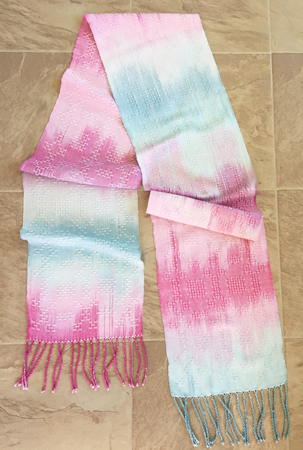
In fact, I like the scarf well enough that I decided to spend the extra time to add a bit of pizzaz to the fringe, this time twisting tiny pearlized seed beads into each bundle of fringe.
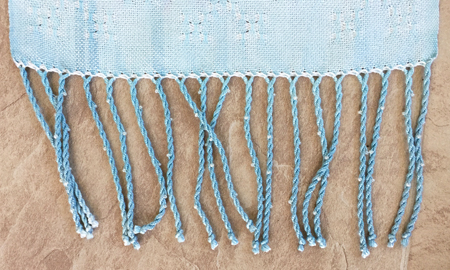
I thought I’d planned enough warp length for one fringed scarf, one short cowl, and one long cowl. However after my experience with the blue warp (above), I figured I’d better approach the project a bit differently than usual. I wove the fringed scarf, then the short cowl so that the third piece would be as long as it could, whether that was a long or short cowl.
In my continuing desire to use up my stash, I only had a small amount of lavender cashmere-silk so decided to use that for the short cowl. This isn’t a great photo, but I’m happy with the piece.
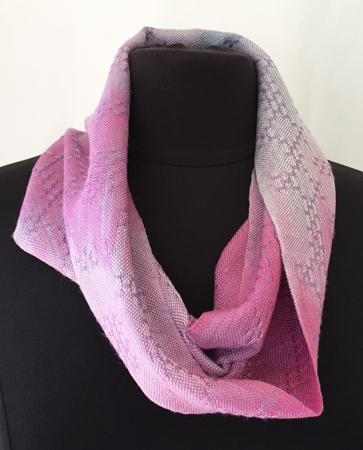
Time for the long cowl. I decided to stick with pale wefts, and chose some 60/2 pink silk. I knew I’d need to use it doubled, and the 2 partial cones of pink I had were different shades, but I figured they’d work fine together, 1 of each. And they do.
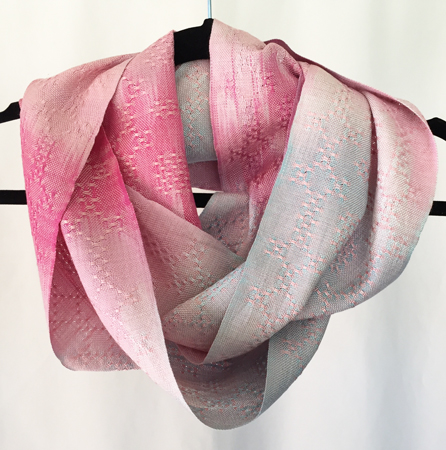
Surprisingly, I had enough warp left for another short cowl. This time I picked baby blue 60/2 silk. I only had one partial cone of it, so had to wind some onto a tube first so I could double it for weft. I really like this one, too, although again it’s not a great photo.
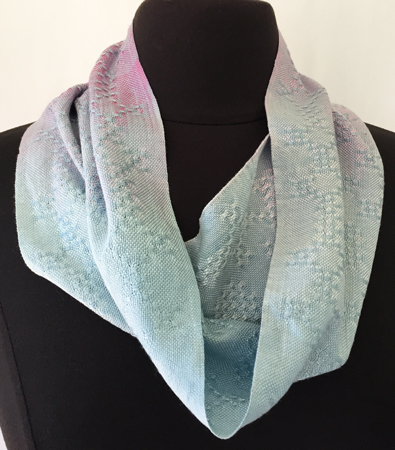
I just realized that none of those photos shows off the huck trellis pattern I am proud of, so here it is. Need a wif? Let me know.
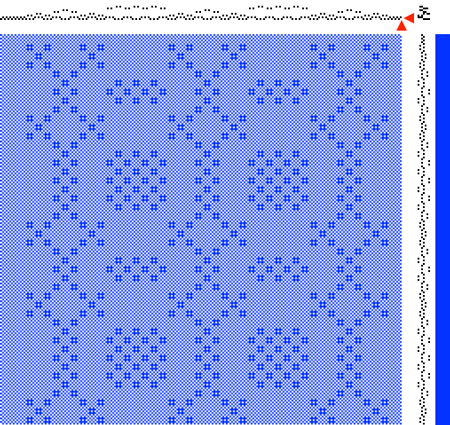
So six down, three to go by the end of the month. I’ll be ahead of the game.
Last week I had to spend 8 hours at the Weaving & Fiber Arts Center so that HVAC techs could fix a problem with our heating and cooling. I brought lots of things to do, some for the Center, some for me. As always, I didn’t get them all done — one of them was writing a blog post. 😉
I did bring lots of clean pillowcases and my sewing machine to make bags for the upcoming season. Got them all cut, but only about half of them sewn. So when we had a stunningly beautiful day on Thursday, moderate temperatures, pleasant breeze, I brought my things outside and finished the sewing in the shade in my backyard.

I was wishing my looms were so easy to move. Only the rigid heddle and the tapestry loom are. I generally only use the rigid heddle to demo at shows, and the tapestry thing is new to me and will likely never be for sale, so I am tied to my floor looms in my studio. Gorgeous though it is, isn’t not outside.
Several days ago, while I had a warp on the loom, I decided it was the perfect opportunity to dye two warps that would be woven in June – probably my last before the show season starts. So I prepared and dyed one warp in tencel and one in silk. The last few times I’ve dyed I not only made careful notes about the formulas I used to mix my colors, but also saved actual samples of the dyed yarn. It assured that I got what I’d planned for in my blue and green tencel warp.
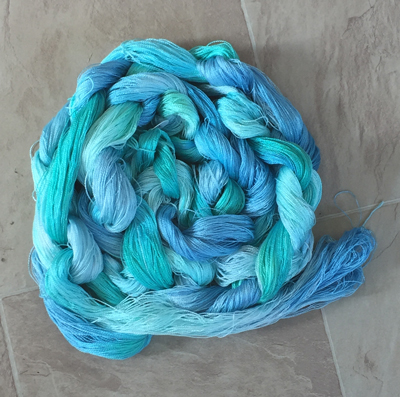
The silk? Not so much. I wanted blue-violet, red-violet, and periwinkle. Like the purple-blue half of the tencel in this photo (this is two chains wound together).
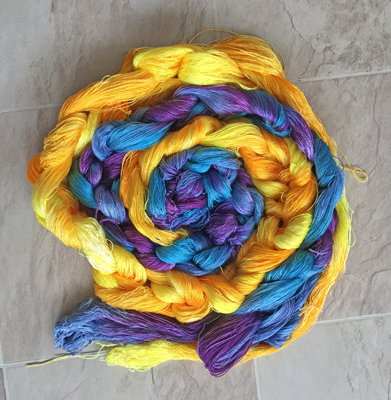
What I got is COMPLETELY different! Not. Even. Close.
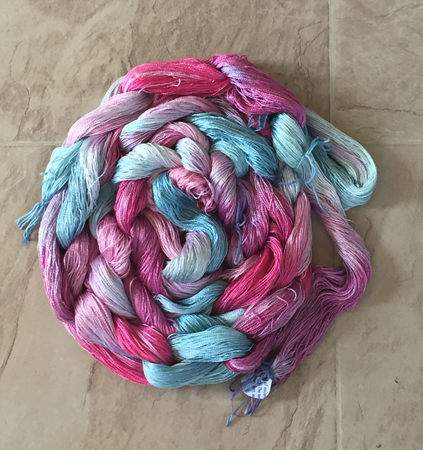
It started in the basement. I’d made note that when I painted on the blue-violet and red-violet on the tencel that they both looked quite gray. Not so on the silk; they both looked bright. But then after they were batched, rinsed and dried, there wasn’t a bit of blue in the violets, only fuschia, and the supposed periwinkle was a pale blue. Sigh.
Honestly, I think it’s as straightforward as the difference in the fibers, but only future dyeing will confirm that or blow holes through it. Double sigh.
So what did I have on the loom while I did the dyeing? A silk warp, transitioning from solid blue at one selvedge to solid green at the other. I threaded and tied up the loom for one of my favorite patterns, that I’ve called feathers. I also mix it up by treadling as zigs instead of feathers. That’s what I did for the first scarf, with a black warp.
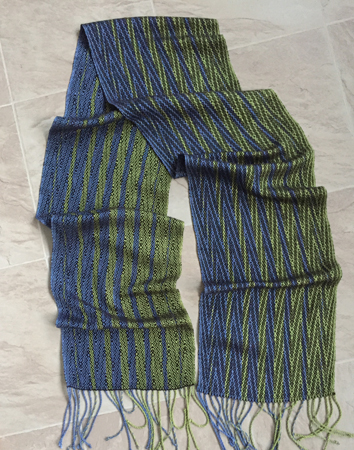
When I started weaving this scarf, I thought I was using black silk, but after I got several inches woven I realized it was tencel on my bobbin. Rather than unweave those several inches, I shrugged my shoulders and continued with the tencel, which is a bit heavier than the silk warp.
Interesting how the colors play differently with the pattern on the two sides of this scarf, isn’t it?

For the second scarf I wove with a very fine purple cashmere-silk blend. This scarf is SOOOOO lightweight.
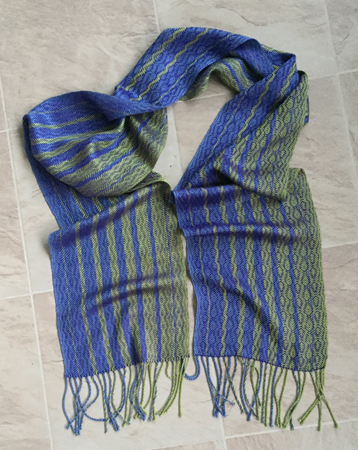
It is, as Mary Poppins would say, practically perfect in every way.
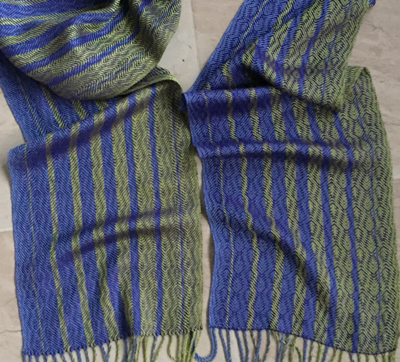
Finally I wove a long cowl with a medium blue silk in the same weight as the warp.
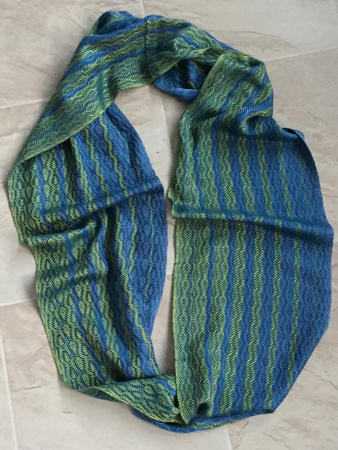
I’ve gotten 2 more silk scarves woven, but am still working on finishing, so you’ll see them next time.
Although I still haven’t wet finished the silk scarves I wove, the 4-selvedge, tiny tapestry concept was pulling me in. I just cut this off the loom, and wet finishing needs to be done.
The color meanings are the same as the last one, and as the scarf for the exhibit, with the addition of green to represent money behind the power. The total size is approximately 5.5″ x 3.75″. Considering my inexperience with tapestry, I am proud of this piece. I understood more about tapestry techniques so made fewer weaving mistakes than last time, and was able to unweave and fix the ones I made.

I’m pretty sure I’ll have to make more tiny tapestries.
|
|






































